Actual vs. Perceived Staffing Needs in a General Hospital Report
VerifiedAdded on 2022/03/08
|7
|1716
|22
Report
AI Summary
This report examines the critical issue of hospital staffing, comparing the Hour per Patient Day (HpPD) and Acuity methods to determine actual and perceived staffing needs. The study highlights the impact of inadequate staffing on patient care quality and safety, referencing existing research...
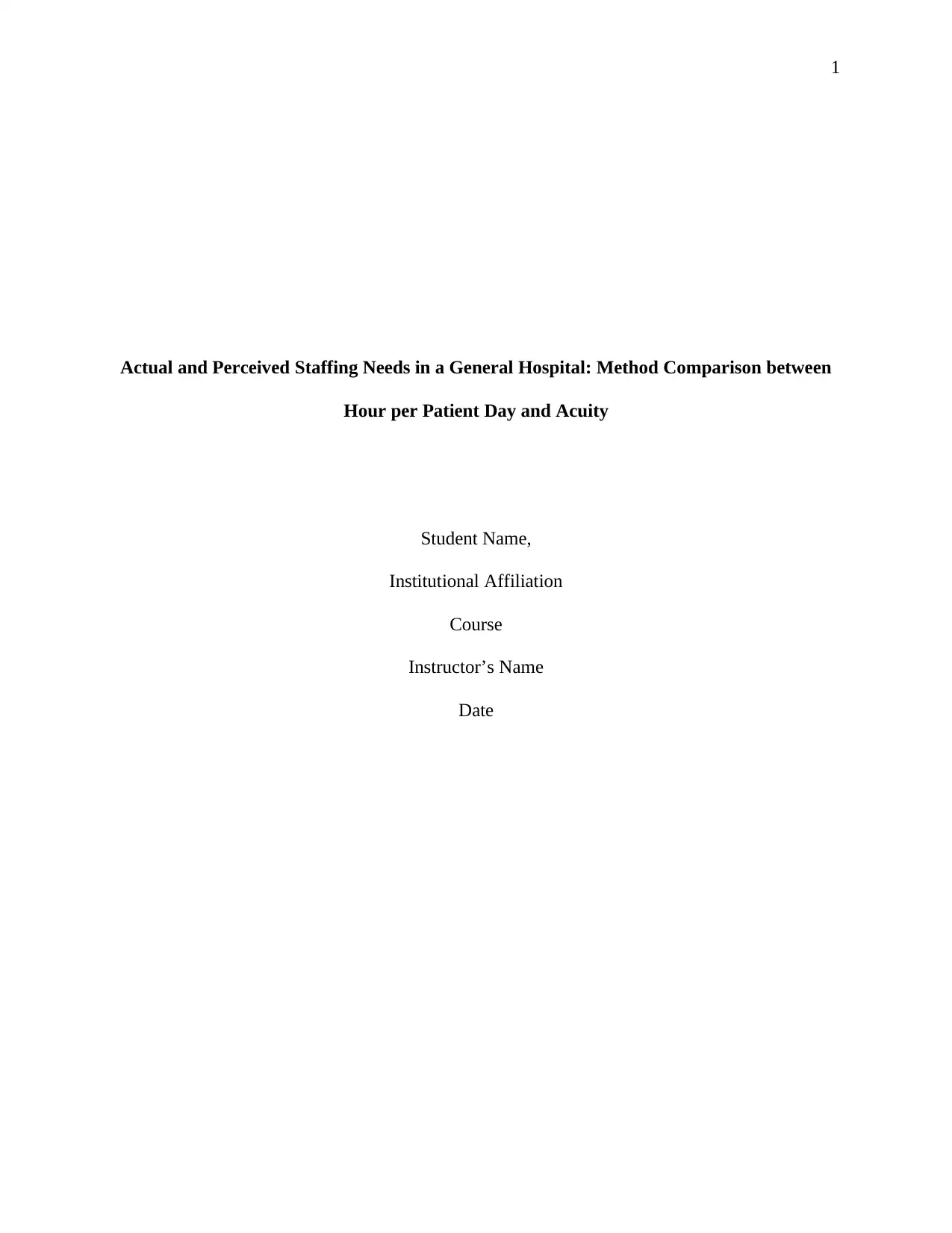
1
Actual and Perceived Staffing Needs in a General Hospital: Method Comparison between
Hour per Patient Day and Acuity
Student Name,
Institutional Affiliation
Course
Instructor’s Name
Date
Actual and Perceived Staffing Needs in a General Hospital: Method Comparison between
Hour per Patient Day and Acuity
Student Name,
Institutional Affiliation
Course
Instructor’s Name
Date
Paraphrase This Document
Need a fresh take? Get an instant paraphrase of this document with our AI Paraphraser
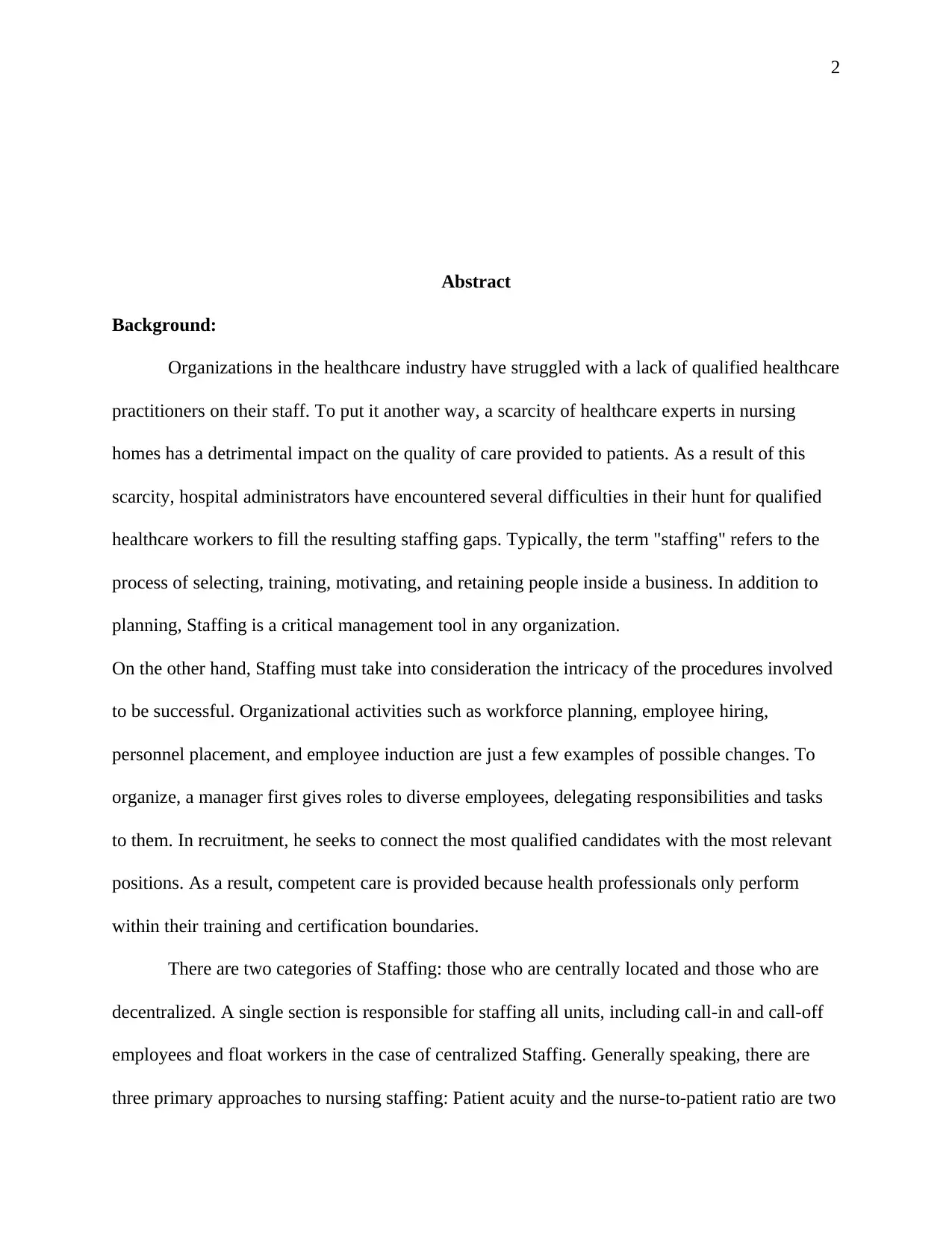
2
Abstract
Background:
Organizations in the healthcare industry have struggled with a lack of qualified healthcare
practitioners on their staff. To put it another way, a scarcity of healthcare experts in nursing
homes has a detrimental impact on the quality of care provided to patients. As a result of this
scarcity, hospital administrators have encountered several difficulties in their hunt for qualified
healthcare workers to fill the resulting staffing gaps. Typically, the term "staffing" refers to the
process of selecting, training, motivating, and retaining people inside a business. In addition to
planning, Staffing is a critical management tool in any organization.
On the other hand, Staffing must take into consideration the intricacy of the procedures involved
to be successful. Organizational activities such as workforce planning, employee hiring,
personnel placement, and employee induction are just a few examples of possible changes. To
organize, a manager first gives roles to diverse employees, delegating responsibilities and tasks
to them. In recruitment, he seeks to connect the most qualified candidates with the most relevant
positions. As a result, competent care is provided because health professionals only perform
within their training and certification boundaries.
There are two categories of Staffing: those who are centrally located and those who are
decentralized. A single section is responsible for staffing all units, including call-in and call-off
employees and float workers in the case of centralized Staffing. Generally speaking, there are
three primary approaches to nursing staffing: Patient acuity and the nurse-to-patient ratio are two
Abstract
Background:
Organizations in the healthcare industry have struggled with a lack of qualified healthcare
practitioners on their staff. To put it another way, a scarcity of healthcare experts in nursing
homes has a detrimental impact on the quality of care provided to patients. As a result of this
scarcity, hospital administrators have encountered several difficulties in their hunt for qualified
healthcare workers to fill the resulting staffing gaps. Typically, the term "staffing" refers to the
process of selecting, training, motivating, and retaining people inside a business. In addition to
planning, Staffing is a critical management tool in any organization.
On the other hand, Staffing must take into consideration the intricacy of the procedures involved
to be successful. Organizational activities such as workforce planning, employee hiring,
personnel placement, and employee induction are just a few examples of possible changes. To
organize, a manager first gives roles to diverse employees, delegating responsibilities and tasks
to them. In recruitment, he seeks to connect the most qualified candidates with the most relevant
positions. As a result, competent care is provided because health professionals only perform
within their training and certification boundaries.
There are two categories of Staffing: those who are centrally located and those who are
decentralized. A single section is responsible for staffing all units, including call-in and call-off
employees and float workers in the case of centralized Staffing. Generally speaking, there are
three primary approaches to nursing staffing: Patient acuity and the nurse-to-patient ratio are two
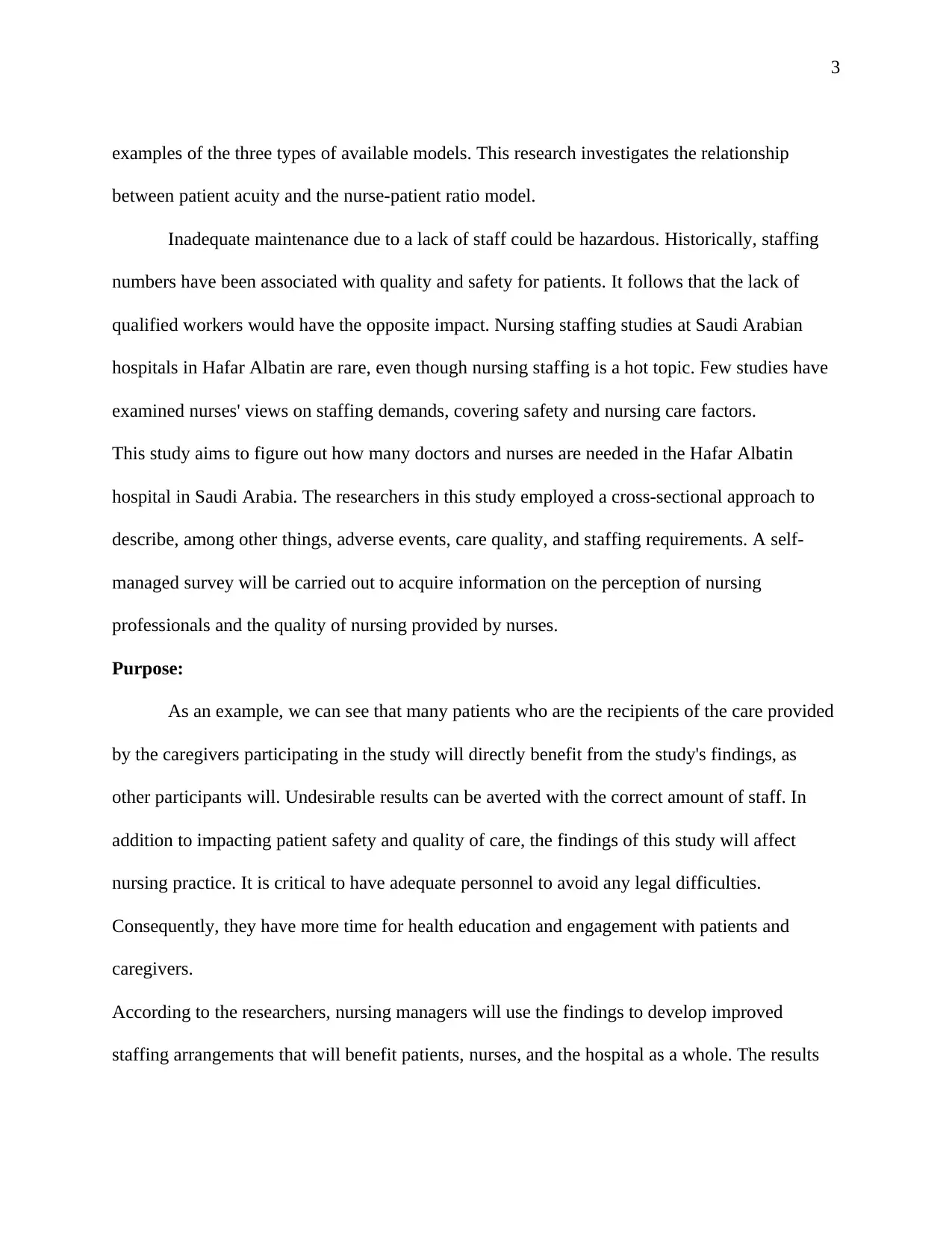
3
examples of the three types of available models. This research investigates the relationship
between patient acuity and the nurse-patient ratio model.
Inadequate maintenance due to a lack of staff could be hazardous. Historically, staffing
numbers have been associated with quality and safety for patients. It follows that the lack of
qualified workers would have the opposite impact. Nursing staffing studies at Saudi Arabian
hospitals in Hafar Albatin are rare, even though nursing staffing is a hot topic. Few studies have
examined nurses' views on staffing demands, covering safety and nursing care factors.
This study aims to figure out how many doctors and nurses are needed in the Hafar Albatin
hospital in Saudi Arabia. The researchers in this study employed a cross-sectional approach to
describe, among other things, adverse events, care quality, and staffing requirements. A self-
managed survey will be carried out to acquire information on the perception of nursing
professionals and the quality of nursing provided by nurses.
Purpose:
As an example, we can see that many patients who are the recipients of the care provided
by the caregivers participating in the study will directly benefit from the study's findings, as
other participants will. Undesirable results can be averted with the correct amount of staff. In
addition to impacting patient safety and quality of care, the findings of this study will affect
nursing practice. It is critical to have adequate personnel to avoid any legal difficulties.
Consequently, they have more time for health education and engagement with patients and
caregivers.
According to the researchers, nursing managers will use the findings to develop improved
staffing arrangements that will benefit patients, nurses, and the hospital as a whole. The results
examples of the three types of available models. This research investigates the relationship
between patient acuity and the nurse-patient ratio model.
Inadequate maintenance due to a lack of staff could be hazardous. Historically, staffing
numbers have been associated with quality and safety for patients. It follows that the lack of
qualified workers would have the opposite impact. Nursing staffing studies at Saudi Arabian
hospitals in Hafar Albatin are rare, even though nursing staffing is a hot topic. Few studies have
examined nurses' views on staffing demands, covering safety and nursing care factors.
This study aims to figure out how many doctors and nurses are needed in the Hafar Albatin
hospital in Saudi Arabia. The researchers in this study employed a cross-sectional approach to
describe, among other things, adverse events, care quality, and staffing requirements. A self-
managed survey will be carried out to acquire information on the perception of nursing
professionals and the quality of nursing provided by nurses.
Purpose:
As an example, we can see that many patients who are the recipients of the care provided
by the caregivers participating in the study will directly benefit from the study's findings, as
other participants will. Undesirable results can be averted with the correct amount of staff. In
addition to impacting patient safety and quality of care, the findings of this study will affect
nursing practice. It is critical to have adequate personnel to avoid any legal difficulties.
Consequently, they have more time for health education and engagement with patients and
caregivers.
According to the researchers, nursing managers will use the findings to develop improved
staffing arrangements that will benefit patients, nurses, and the hospital as a whole. The results
⊘ This is a preview!⊘
Do you want full access?
Subscribe today to unlock all pages.

Trusted by 1+ million students worldwide
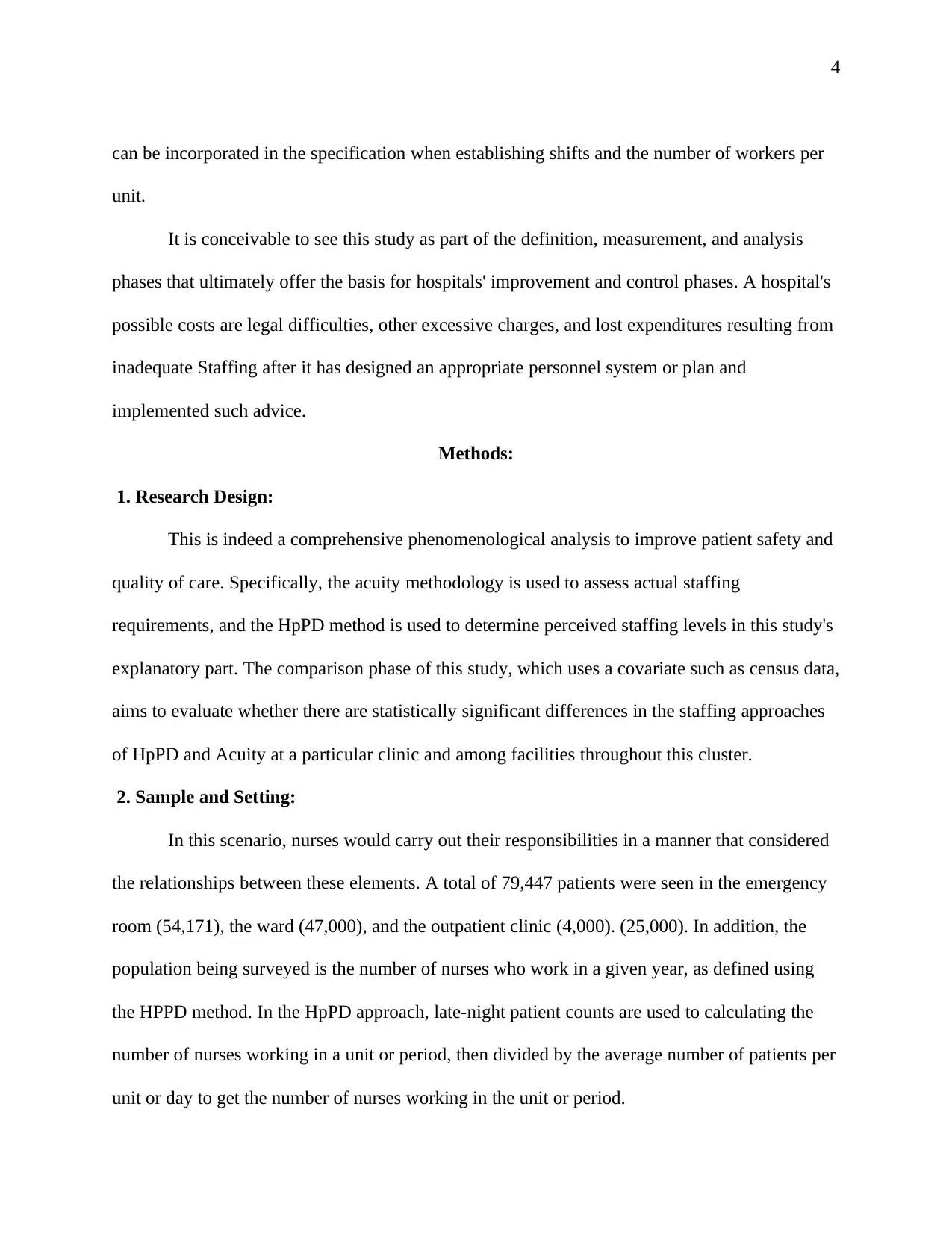
4
can be incorporated in the specification when establishing shifts and the number of workers per
unit.
It is conceivable to see this study as part of the definition, measurement, and analysis
phases that ultimately offer the basis for hospitals' improvement and control phases. A hospital's
possible costs are legal difficulties, other excessive charges, and lost expenditures resulting from
inadequate Staffing after it has designed an appropriate personnel system or plan and
implemented such advice.
Methods:
1. Research Design:
This is indeed a comprehensive phenomenological analysis to improve patient safety and
quality of care. Specifically, the acuity methodology is used to assess actual staffing
requirements, and the HpPD method is used to determine perceived staffing levels in this study's
explanatory part. The comparison phase of this study, which uses a covariate such as census data,
aims to evaluate whether there are statistically significant differences in the staffing approaches
of HpPD and Acuity at a particular clinic and among facilities throughout this cluster.
2. Sample and Setting:
In this scenario, nurses would carry out their responsibilities in a manner that considered
the relationships between these elements. A total of 79,447 patients were seen in the emergency
room (54,171), the ward (47,000), and the outpatient clinic (4,000). (25,000). In addition, the
population being surveyed is the number of nurses who work in a given year, as defined using
the HPPD method. In the HpPD approach, late-night patient counts are used to calculating the
number of nurses working in a unit or period, then divided by the average number of patients per
unit or day to get the number of nurses working in the unit or period.
can be incorporated in the specification when establishing shifts and the number of workers per
unit.
It is conceivable to see this study as part of the definition, measurement, and analysis
phases that ultimately offer the basis for hospitals' improvement and control phases. A hospital's
possible costs are legal difficulties, other excessive charges, and lost expenditures resulting from
inadequate Staffing after it has designed an appropriate personnel system or plan and
implemented such advice.
Methods:
1. Research Design:
This is indeed a comprehensive phenomenological analysis to improve patient safety and
quality of care. Specifically, the acuity methodology is used to assess actual staffing
requirements, and the HpPD method is used to determine perceived staffing levels in this study's
explanatory part. The comparison phase of this study, which uses a covariate such as census data,
aims to evaluate whether there are statistically significant differences in the staffing approaches
of HpPD and Acuity at a particular clinic and among facilities throughout this cluster.
2. Sample and Setting:
In this scenario, nurses would carry out their responsibilities in a manner that considered
the relationships between these elements. A total of 79,447 patients were seen in the emergency
room (54,171), the ward (47,000), and the outpatient clinic (4,000). (25,000). In addition, the
population being surveyed is the number of nurses who work in a given year, as defined using
the HPPD method. In the HpPD approach, late-night patient counts are used to calculating the
number of nurses working in a unit or period, then divided by the average number of patients per
unit or day to get the number of nurses working in the unit or period.
Paraphrase This Document
Need a fresh take? Get an instant paraphrase of this document with our AI Paraphraser
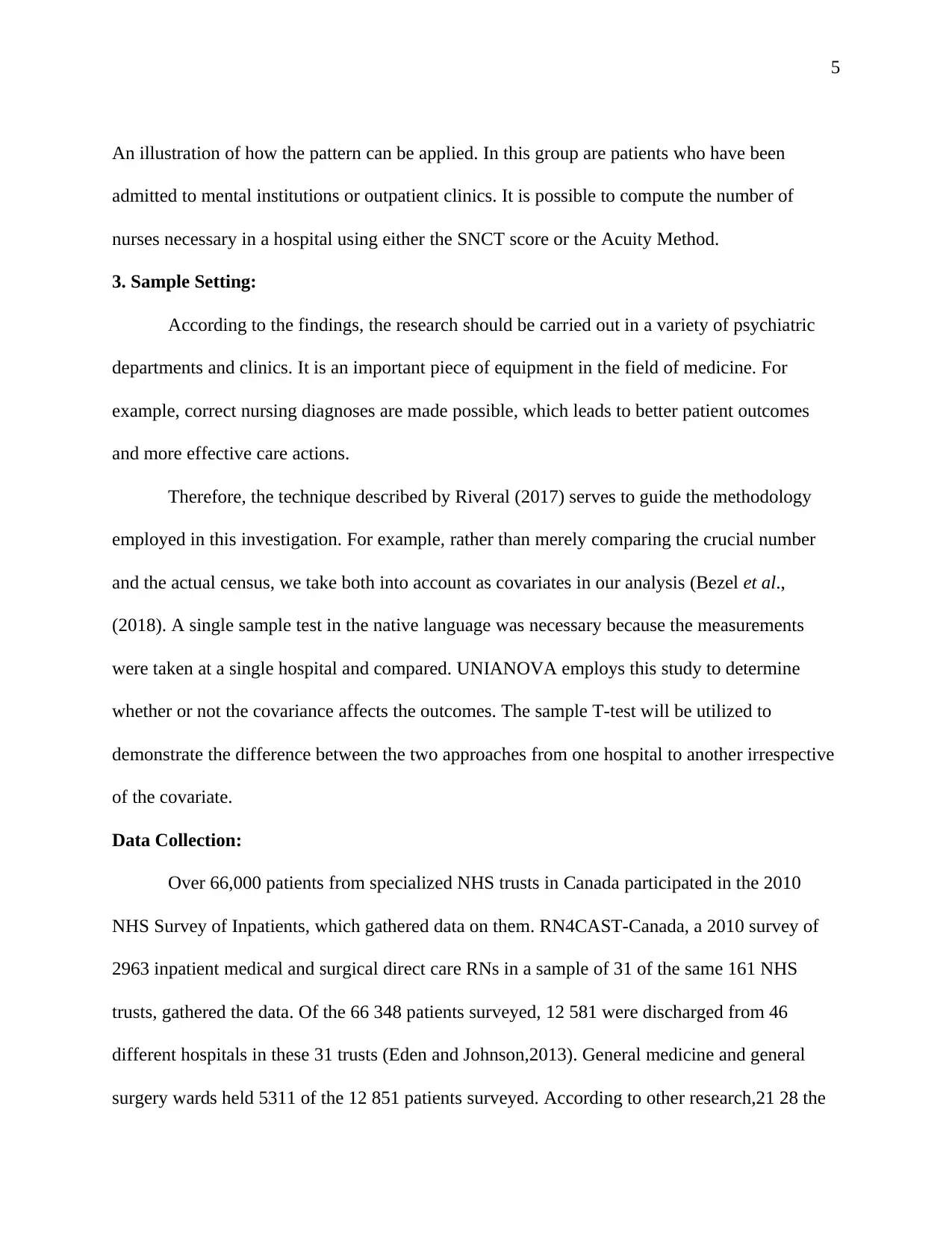
5
An illustration of how the pattern can be applied. In this group are patients who have been
admitted to mental institutions or outpatient clinics. It is possible to compute the number of
nurses necessary in a hospital using either the SNCT score or the Acuity Method.
3. Sample Setting:
According to the findings, the research should be carried out in a variety of psychiatric
departments and clinics. It is an important piece of equipment in the field of medicine. For
example, correct nursing diagnoses are made possible, which leads to better patient outcomes
and more effective care actions.
Therefore, the technique described by Riveral (2017) serves to guide the methodology
employed in this investigation. For example, rather than merely comparing the crucial number
and the actual census, we take both into account as covariates in our analysis (Bezel et al.,
(2018). A single sample test in the native language was necessary because the measurements
were taken at a single hospital and compared. UNIANOVA employs this study to determine
whether or not the covariance affects the outcomes. The sample T-test will be utilized to
demonstrate the difference between the two approaches from one hospital to another irrespective
of the covariate.
Data Collection:
Over 66,000 patients from specialized NHS trusts in Canada participated in the 2010
NHS Survey of Inpatients, which gathered data on them. RN4CAST-Canada, a 2010 survey of
2963 inpatient medical and surgical direct care RNs in a sample of 31 of the same 161 NHS
trusts, gathered the data. Of the 66 348 patients surveyed, 12 581 were discharged from 46
different hospitals in these 31 trusts (Eden and Johnson,2013). General medicine and general
surgery wards held 5311 of the 12 851 patients surveyed. According to other research,21 28 the
An illustration of how the pattern can be applied. In this group are patients who have been
admitted to mental institutions or outpatient clinics. It is possible to compute the number of
nurses necessary in a hospital using either the SNCT score or the Acuity Method.
3. Sample Setting:
According to the findings, the research should be carried out in a variety of psychiatric
departments and clinics. It is an important piece of equipment in the field of medicine. For
example, correct nursing diagnoses are made possible, which leads to better patient outcomes
and more effective care actions.
Therefore, the technique described by Riveral (2017) serves to guide the methodology
employed in this investigation. For example, rather than merely comparing the crucial number
and the actual census, we take both into account as covariates in our analysis (Bezel et al.,
(2018). A single sample test in the native language was necessary because the measurements
were taken at a single hospital and compared. UNIANOVA employs this study to determine
whether or not the covariance affects the outcomes. The sample T-test will be utilized to
demonstrate the difference between the two approaches from one hospital to another irrespective
of the covariate.
Data Collection:
Over 66,000 patients from specialized NHS trusts in Canada participated in the 2010
NHS Survey of Inpatients, which gathered data on them. RN4CAST-Canada, a 2010 survey of
2963 inpatient medical and surgical direct care RNs in a sample of 31 of the same 161 NHS
trusts, gathered the data. Of the 66 348 patients surveyed, 12 581 were discharged from 46
different hospitals in these 31 trusts (Eden and Johnson,2013). General medicine and general
surgery wards held 5311 of the 12 851 patients surveyed. According to other research,21 28 the
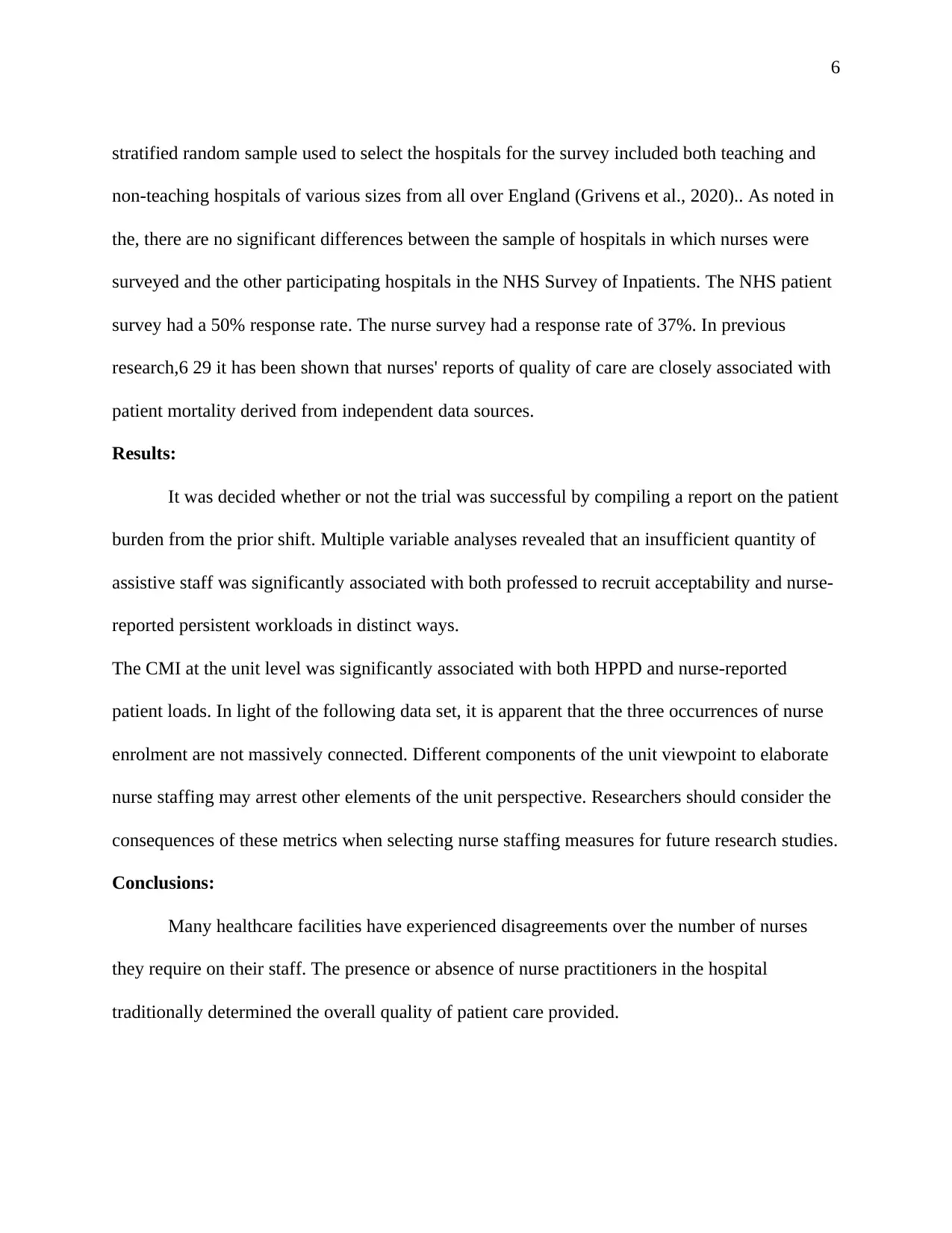
6
stratified random sample used to select the hospitals for the survey included both teaching and
non-teaching hospitals of various sizes from all over England (Grivens et al., 2020).. As noted in
the, there are no significant differences between the sample of hospitals in which nurses were
surveyed and the other participating hospitals in the NHS Survey of Inpatients. The NHS patient
survey had a 50% response rate. The nurse survey had a response rate of 37%. In previous
research,6 29 it has been shown that nurses' reports of quality of care are closely associated with
patient mortality derived from independent data sources.
Results:
It was decided whether or not the trial was successful by compiling a report on the patient
burden from the prior shift. Multiple variable analyses revealed that an insufficient quantity of
assistive staff was significantly associated with both professed to recruit acceptability and nurse-
reported persistent workloads in distinct ways.
The CMI at the unit level was significantly associated with both HPPD and nurse-reported
patient loads. In light of the following data set, it is apparent that the three occurrences of nurse
enrolment are not massively connected. Different components of the unit viewpoint to elaborate
nurse staffing may arrest other elements of the unit perspective. Researchers should consider the
consequences of these metrics when selecting nurse staffing measures for future research studies.
Conclusions:
Many healthcare facilities have experienced disagreements over the number of nurses
they require on their staff. The presence or absence of nurse practitioners in the hospital
traditionally determined the overall quality of patient care provided.
stratified random sample used to select the hospitals for the survey included both teaching and
non-teaching hospitals of various sizes from all over England (Grivens et al., 2020).. As noted in
the, there are no significant differences between the sample of hospitals in which nurses were
surveyed and the other participating hospitals in the NHS Survey of Inpatients. The NHS patient
survey had a 50% response rate. The nurse survey had a response rate of 37%. In previous
research,6 29 it has been shown that nurses' reports of quality of care are closely associated with
patient mortality derived from independent data sources.
Results:
It was decided whether or not the trial was successful by compiling a report on the patient
burden from the prior shift. Multiple variable analyses revealed that an insufficient quantity of
assistive staff was significantly associated with both professed to recruit acceptability and nurse-
reported persistent workloads in distinct ways.
The CMI at the unit level was significantly associated with both HPPD and nurse-reported
patient loads. In light of the following data set, it is apparent that the three occurrences of nurse
enrolment are not massively connected. Different components of the unit viewpoint to elaborate
nurse staffing may arrest other elements of the unit perspective. Researchers should consider the
consequences of these metrics when selecting nurse staffing measures for future research studies.
Conclusions:
Many healthcare facilities have experienced disagreements over the number of nurses
they require on their staff. The presence or absence of nurse practitioners in the hospital
traditionally determined the overall quality of patient care provided.
⊘ This is a preview!⊘
Do you want full access?
Subscribe today to unlock all pages.

Trusted by 1+ million students worldwide
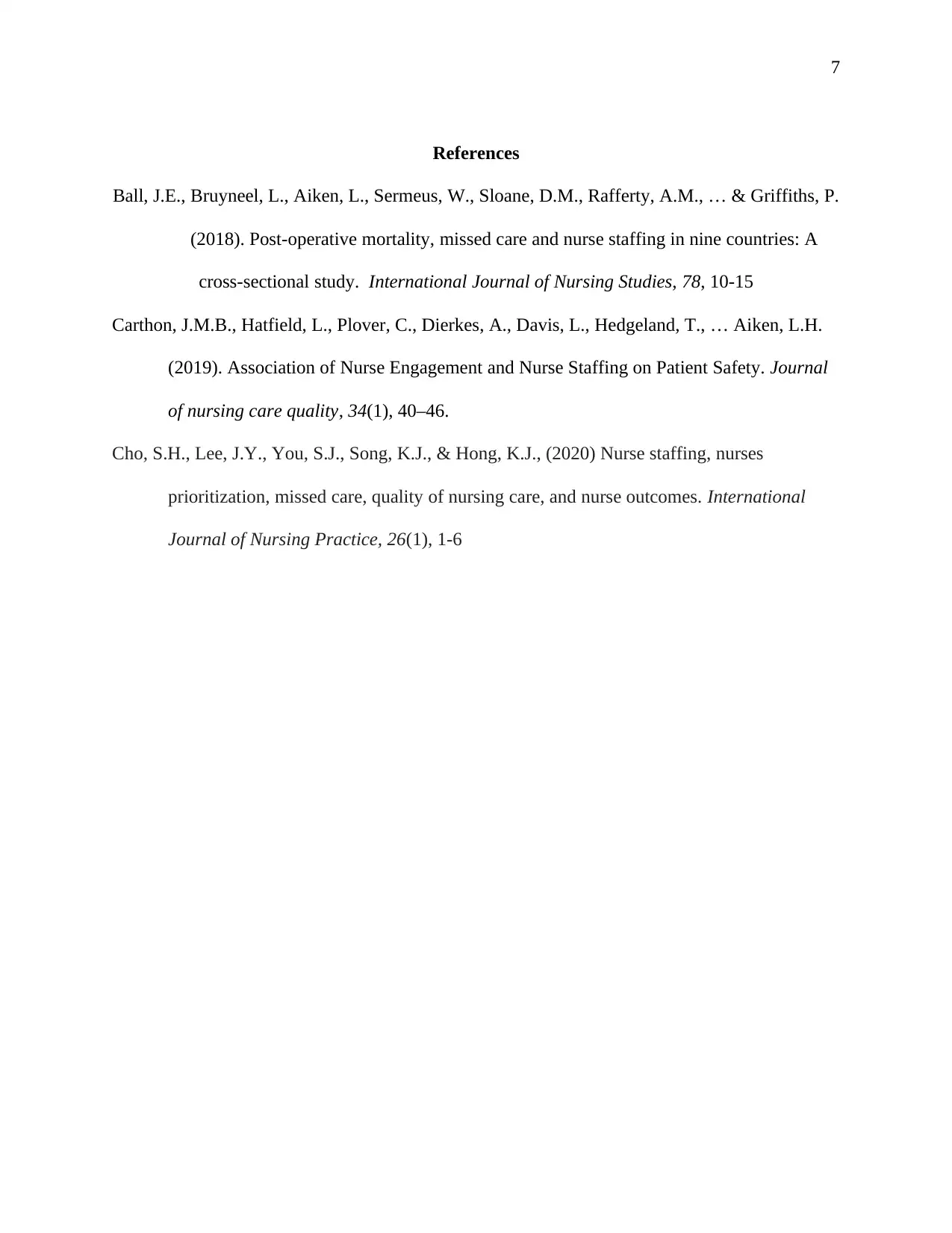
7
References
Ball, J.E., Bruyneel, L., Aiken, L., Sermeus, W., Sloane, D.M., Rafferty, A.M., … & Griffiths, P.
(2018). Post-operative mortality, missed care and nurse staffing in nine countries: A
cross-sectional study. International Journal of Nursing Studies, 78, 10-15
Carthon, J.M.B., Hatfield, L., Plover, C., Dierkes, A., Davis, L., Hedgeland, T., … Aiken, L.H.
(2019). Association of Nurse Engagement and Nurse Staffing on Patient Safety. Journal
of nursing care quality, 34(1), 40–46.
Cho, S.H., Lee, J.Y., You, S.J., Song, K.J., & Hong, K.J., (2020) Nurse staffing, nurses
prioritization, missed care, quality of nursing care, and nurse outcomes. International
Journal of Nursing Practice, 26(1), 1-6
References
Ball, J.E., Bruyneel, L., Aiken, L., Sermeus, W., Sloane, D.M., Rafferty, A.M., … & Griffiths, P.
(2018). Post-operative mortality, missed care and nurse staffing in nine countries: A
cross-sectional study. International Journal of Nursing Studies, 78, 10-15
Carthon, J.M.B., Hatfield, L., Plover, C., Dierkes, A., Davis, L., Hedgeland, T., … Aiken, L.H.
(2019). Association of Nurse Engagement and Nurse Staffing on Patient Safety. Journal
of nursing care quality, 34(1), 40–46.
Cho, S.H., Lee, J.Y., You, S.J., Song, K.J., & Hong, K.J., (2020) Nurse staffing, nurses
prioritization, missed care, quality of nursing care, and nurse outcomes. International
Journal of Nursing Practice, 26(1), 1-6
1 out of 7
Related Documents
Your All-in-One AI-Powered Toolkit for Academic Success.
+13062052269
info@desklib.com
Available 24*7 on WhatsApp / Email
![[object Object]](/_next/static/media/star-bottom.7253800d.svg)
Unlock your academic potential
© 2024 | Zucol Services PVT LTD | All rights reserved.





